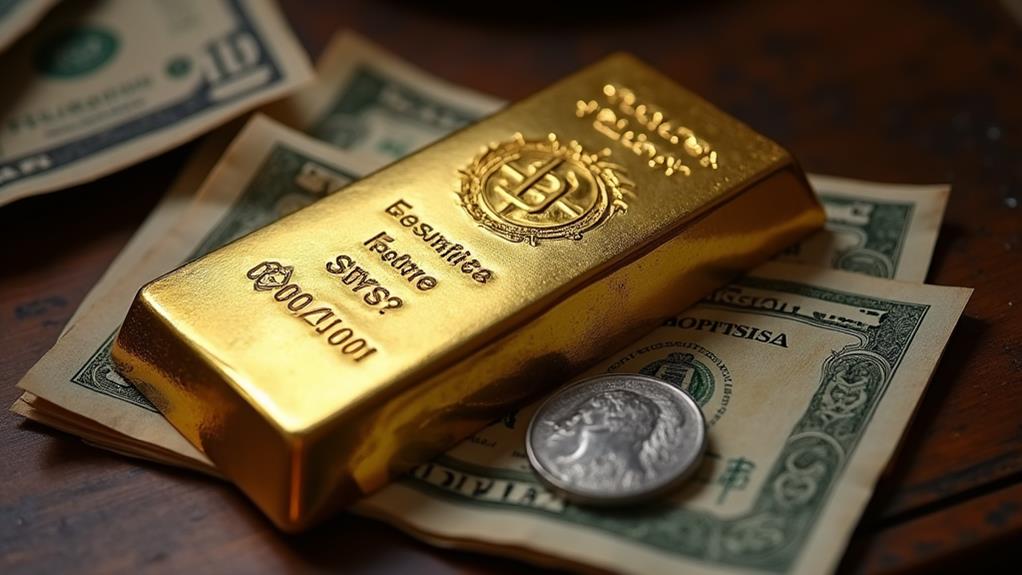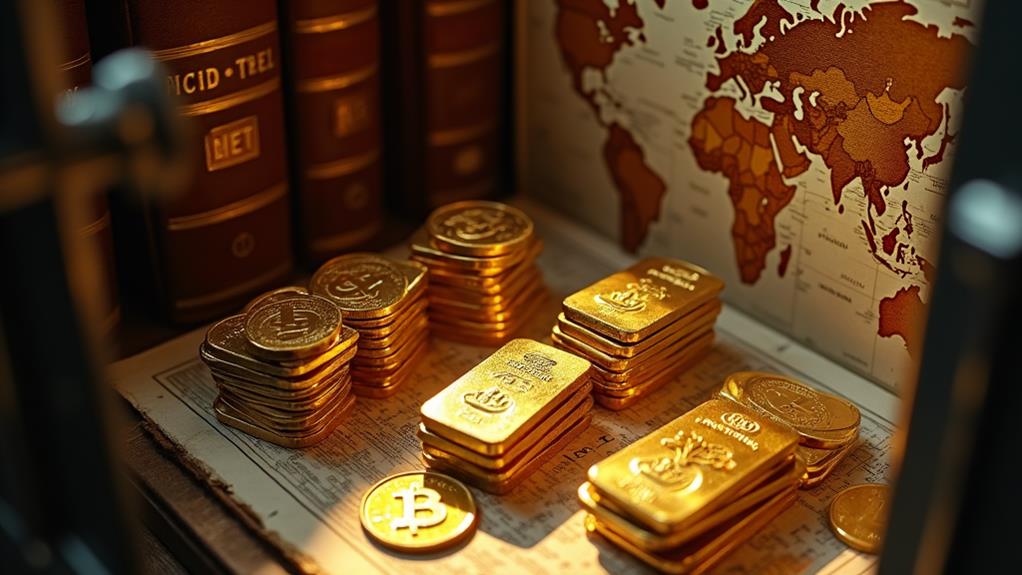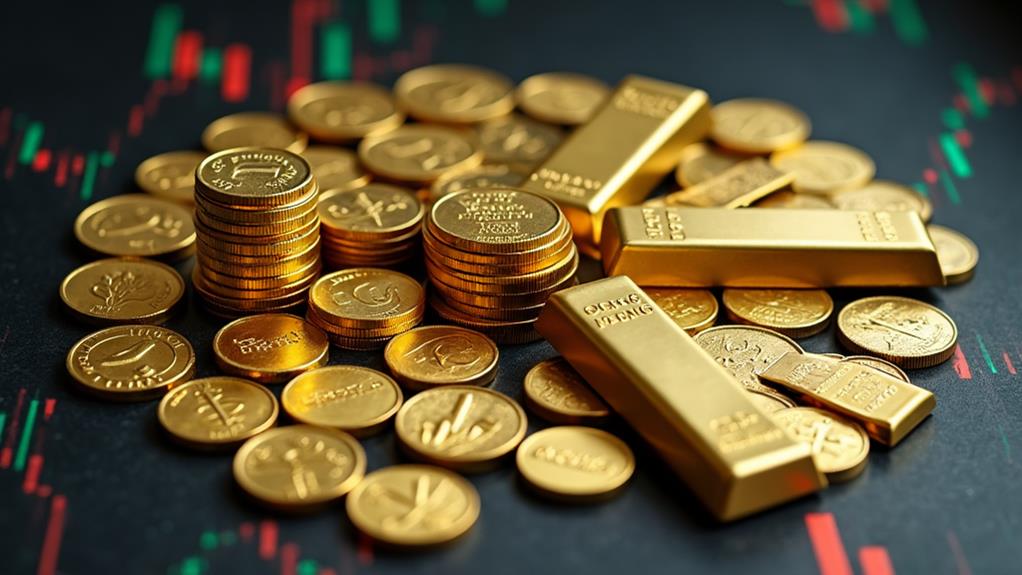Peter Schiff's gold investment strategy has attracted significant attention in financial circles, offering a unique perspective on wealth preservation and market dynamics. His approach, rooted in a deep understanding of gold's essential value and its role in the global economy, challenges conventional investment wisdom. By emphasizing physical ownership and long-term holding, Schiff's strategy departs from typical market practices. While his views on inflation protection and dollar skepticism have sparked debate, they've likewise prompted investors to reconsider their portfolio allocations. As economic uncertainties persist, examining the fundamental principles behind Schiff's strategy becomes increasingly relevant for those seeking to traverse complex financial landscapes.
Key Insights
- Gold is viewed as a long-term store of value and hedge against inflation and economic uncertainty.
- Physical ownership of gold is preferred over paper assets to eliminate counterparty risks.
- Skepticism towards the U.S. dollar's stability drives the need for gold as a wealth preservation tool.
- Portfolio diversification with significant allocation to precious metals, including physical gold and mining stocks.
- Continuous global economic analysis informs investment decisions, with emphasis on central bank policies and market trends.
Understanding Gold's Intrinsic Value

Three crucial factors underpin gold's fundamental value according to Peter Schiff's investment philosophy.
First, gold serves as a reliable inflation hedge, protecting wealth against currency devaluation.
Second, its status as a safe haven asset makes it attractive during global economic crises.
Third, gold's long-term value preservation capabilities make it a cornerstone of diversification strategies.
Schiff emphasizes the importance of understanding gold's inherent value in precious metals investment:
- Limited supply: Unlike fiat currencies, gold bullion cannot be printed at will.
- Historical significance: Gold has been valued for millennia across cultures.
- Industrial applications: Beyond jewelry, gold has practical uses in technology.
"Gold's value is not derived from government decree, but from its unique properties and global demand," Schiff notes.
He advises investors to consider gold supply and demand dynamics when evaluating its potential as a wealth preservation tool.
Long-Term Perspective
Peter Schiff's gold investment strategy emphasizes a long-term perspective, urging investors to look beyond short-term market fluctuations. He advocates for a diversified portfolio that includes physical gold, such as gold bars and gold coins, as a hedge against inflation and economic uncertainty.
Schiff believes that maintaining a consistent asset allocation in precious metals can protect purchasing power over time.
Key points of Schiff's long-term gold investment approach:
- Focus on gold as a store of value rather than a short-term trading vehicle
- Gradually accumulate gold over time to average out price fluctuations
- Consider gold a vital component of a well-balanced investment portfolio
- View temporary price dips as buying opportunities for long-term investors
"Gold's historical performance demonstrates its ability to preserve wealth across generations," Schiff often states, emphasizing the importance of patience and commitment to a long-term investment strategy in precious metals.
Physical Ownership Preference

While Schiff's long-term perspective forms the foundation of his investment philosophy, his preference for physical gold ownership is also fundamental.
Peter Schiff strongly advocates for holding tangible, physical precious metals as part of an investment strategy. He emphasizes the importance of bullion ownership, particularly through vehicles like gold IRAs, which allow investors to allocate a portion of their retirement savings to physical gold.
Schiff argues that physical ownership provides improved security and integrity compared to paper gold assets. By directly holding bullion, investors maintain complete control over their gold, eliminating counterparty risks associated with financial institutions.
This approach aligns with Schiff's experience-based belief that tangible assets offer superior protection against economic uncertainties and currency devaluation.
On the other hand, investors should carefully consider storage and insurance costs when opting for physical gold ownership, as these factors can impact overall returns.
Global Economic Analysis
Central to Peter Schiff's gold investment strategy is his comprehensive analysis of global economic trends. He closely monitors central bank policies, global markets, and monetary policies to inform his investment decisions. Schiff's approach emphasizes the potential for economic collapse and the vulnerability of fiat currencies.
| Economic Factor | Impact on Gold | Schiff's Perspective |
|---|---|---|
| Quantitative Easing | Inflationary pressure | Bullish for gold |
| Economic Uncertainty | Safe-haven demand | Supports gold prices |
| Fiat Currency Devaluation | Increased gold value | Validates gold investment |
| Global Market Volatility | Flight to safety | Favors gold holdings |
Schiff provides regular market updates, highlighting how global economic conditions influence gold prices. He argues that understanding the interconnectedness of the global economy is essential for successful gold investing. By analyzing economic indicators and policy decisions, Schiff aims to anticipate market shifts and position investments accordingly.
Inflation Protection Focus

A cornerstone of Schiff's gold investment strategy is its focus on inflation protection. He advocates for investing in precious metals, particularly gold, as a hedge against inflation and economic uncertainty. Schiff's approach emphasizes the potential for gold to maintain its value while fiat currencies depreciate during inflationary periods.
Key aspects of Schiff's inflation protection strategy include:
- Allocating a significant portion of one's portfolio to gold
- Monitoring global monetary policies and their impact on inflation
- Understanding the relationship between gold prices and economic indicators
- Varying investments across various forms of gold (physical, ETFs, mining stocks)
Schiff's gold price predictions often factor in potential inflationary pressures and economic instability. He argues that as a commodity, gold offers a reliable store of value during times of monetary uncertainty.
This strategy aims to safeguard wealth against the erosive effects of inflation, positioning gold as a vital component of a well-rounded investment portfolio.
Dollar Skepticism
Peter Schiff's gold investment strategy is deeply rooted in his skepticism towards the U.S. dollar. As the founder of Euro Pacific Capital, Schiff argues that the dollar's status as the world's reserve currency is unsustainable.
He cites factors such as:
- Rising U.S. sovereign debt
- Low interest rates
- Potential for economic recession
Schiff contends that these issues will lead to a weakening of the dollar against other currencies, particularly the euro. He warns that this decline could trigger inflation and erode the purchasing power of dollar-denominated assets.
"The U.S. dollar is living on borrowed time," Schiff states, emphasizing the need for investors to explore into gold as a hedge against currency devaluation.
This skepticism forms a cornerstone of Schiff's investment philosophy, driving his advocacy for gold as a safeguard against potential economic turbulence and dollar depreciation.
Portfolio Allocation Strategies

Peter Schiff's investment strategy emphasizes diversification through precious metals, particularly gold, as a hedge against economic uncertainty.
This approach aims to balance risk and potential rewards by allocating a portion of one's portfolio to assets that may perform well during periods of market volatility or currency devaluation.
While the specific allocation percentages may vary based on individual circumstances, Schiff generally advocates for a significant presence of gold and other precious metals in a well-rounded investment portfolio.
Diversification With Precious Metals
Frequently, investors seeking to protect their wealth against economic uncertainties turn to precious metals as a vital element of portfolio diversification.
Peter Schiff, a proponent of the gold standard, advocates for a significant allocation to precious metals, particularly gold and silver. This strategy aims to hedge against inflation and provide a long-term focus for investment portfolios.
Key aspects of diversification with precious metals include:
- Physical ownership of gold and silver coins or bars
- Investment in gold ETFs for easier liquidity
- Allocation of mining stocks for potential growth
- Consideration of other precious metals like platinum or palladium
While the percentage allocated to precious metals may vary based on individual risk tolerance and financial goals, Schiff generally recommends a higher allocation than traditional portfolio models.
This approach seeks to balance the potential for wealth preservation during economic uncertainty with the need for diversification across asset classes.
Balancing Risk and Reward
Striking a balance between risk and reward is a cornerstone of Peter Schiff's investment philosophy. He advises investors to allocate their portfolios strategically, taking into account both potential gains and risks associated with different sectors. Schiff's approach emphasizes fundamental analysis and valuation, particularly in gold mining stocks.
| Asset Type | Risk Level | Potential Reward |
|---|---|---|
| Physical Gold | Low | Moderate |
| Gold ETFs | Medium | Medium-High |
| Mining Stocks | High | Very High |
Schiff recommends a mix of these assets, tailored to each investor's risk tolerance. He suggests actively managed funds for those seeking insightful sector exposure. Nevertheless, he cautions against overexposure to high-risk investments, advising a balanced approach that aligns with individual financial goals and market conditions. This strategy aims to maximize returns while mitigating potential losses, reflecting Schiff's pragmatic view of the precious metals market.
My Final Thoughts
Peter Schiff's gold investment strategy, reminiscent of ancient civilizations' reliance on precious metals, offers a blueprint for navigating modern economic uncertainties. By emphasizing gold's inherent value, physical ownership, and long-term perspective, this approach aims to safeguard wealth against inflation and currency devaluation. Thorough economic analysis and strategic portfolio allocation form the cornerstone of this strategy. While not without risks, Schiff's method provides a thought-provoking alternative to conventional investment wisdom, challenging investors to reconsider their approach to wealth preservation.







